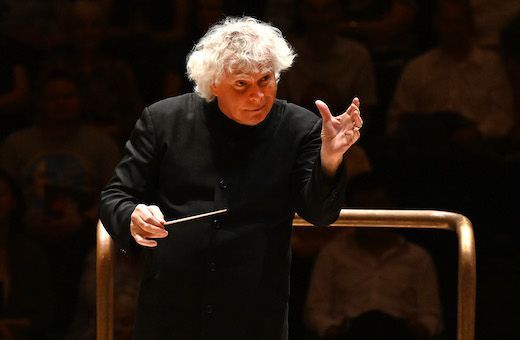If you never permit your palate to sample new and unusual flavours, there’s every chance that your microbiome will be the poorer for it. You could equally argue that if your listening habits are never challenged, your musical perceptions will be a good deal weaker. Histoires vraies, a recent work written by the Franco-American Betsy Jolas for her friends Håkan Hardenberger and Roger Muraro, is not so much a palate cleanser, more a demonstration of the virtues of a calorie-reducing diet.
In this performance with the London Symphony Orchestra under its Music Director Sir Simon Rattle, it was the unconventional that held sway. The larger ensemble tunes up, then there is a rustling of strings and pattering of percussion, before the two soloists and conductor make their appearance. Taking its inspiration from the idea that urban life is filled with all kinds of unwanted auditory detritus – the firing up of car engines, the whirring of laptop fans and the humming of aircon units – the work appears to have no overall structural cohesion. Yet there are recurring patterns: the extensive use of percussive strings, the reiteration of wood-on-wood effects from the percussion and the mesmerising way in which fragments of sound well up and coalesce into huge climaxes before subsiding into the nether regions of consciousness. The extravagance of the piece conjured up all kinds of visual and auditory associations: a cat negotiating a slippery corrugated roof, the cascades of notes and gentle trills from Muraro echoing Stravinsky’s Petrushka, and a feeling that Ives’ The Unanswered Question had outgrown its original confines. But it was the sensational playing of Hardenberger that commanded attention throughout, not least in the many muted sequences.
The concert had begun with a similar teasing of the senses. No performance of Ligeti’s Atmosphères can aim at absolute precision; it’s the changing colours that matter more. A number of small magical details registered: the collective strings replicating a swarm of bees or the woodwind matching the gentle fluttering of birds’ wings or the tantalising use of legerdemain dynamics. From this Rattle elided into the Act 1 Prelude to Wagner’s Lohengrin, with the quality of the LSO strings on display from the start. Yet the Ligeti had already left its mark. Inner voices were not given their due, the textures hovering between the diaphanous and the veiled, spoiled in the central climax by the over-enthusiastic brass.

Rattle never strikes me as being completely at ease in Brahms, yet there were aspects in this performance of the Symphony no. 2 in D major which revealed a probing approach. Taking his cue from the composer’s tongue-in-cheek comment to his publisher that “the score needs to appear edged in black”, the opening movement saw Rattle keen to explore the depths and the darkness, the shadows more than the bright sunlight, aided by the use of antiphonal violins. In the Finale too there was a searching out of murky and mysterious eddies in the fast-flowing water. So far, so good. However, this engagement with the penumbra was somewhat at odds with the forceful and excitable use of the brass in climaxes, heralded already by a prominent horn solo at the start of the work. More worryingly, Rattle repeatedly fell into the old trap of pulling back the tempo in quieter moments, so that the music then became becalmed, most notably in the slow movement where Brahms qualifies the Adagio with non troppo. Lines that were overly manicured, as in the final movement, contrasted starkly with the brass-led eruptions. Molten lava does not have to be forced along, it flows of its own accord.


